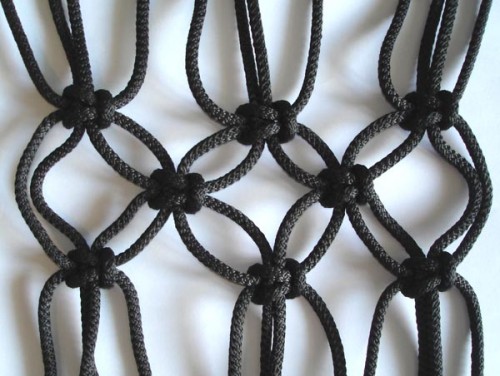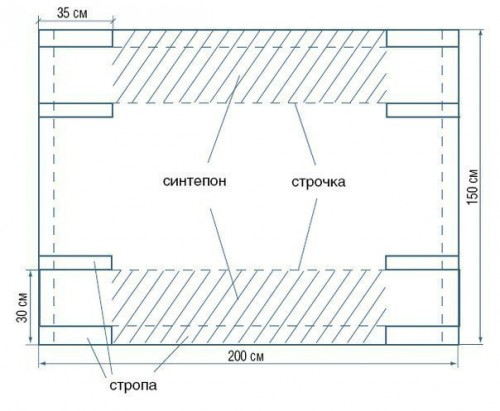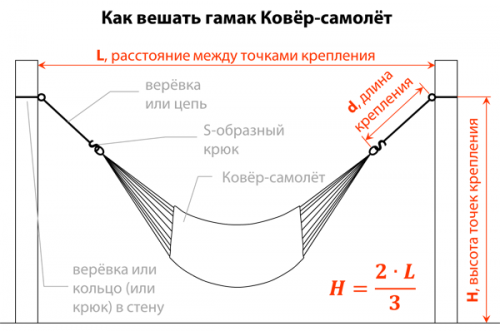Gamak is a cozy and practical design that can ennoble any personal plot. This useful item of the interior is usually used to conduct a short -term rest in order to calmly relax in the shade and enjoy the rustle of foliage. In addition, the aesthetic appearance of the hammock harmoniously fits into the overall design of the site, and to make it with your own hands will not be absolutely no difficult.
Content
General recommendations for the device of hammock
Deciding how to make a hammock with your own hands it is necessary to take into account several features to create the most comfortable design and conduct a long -awaited rest in it. So, when forming a cozy hammock, it is necessary to take into account:
- The material of the canvas - A competent selection of fabric and a well -thought -out design will make the hammock as convenient as possible. For sewing a durable and reliable product, it is recommended to use dense fabric - tarpaulin, camouflage, canvas, mattress tick or calico. The use of strong synthetic materials is undesirable, since they do not allow the body to “breathe”, despite the high characteristics of wear resistance.
- Cords - If you weave a hammock of ropes, then it is better to give preference to natural cotton materials than synthetic. Ropes from natural components are easier to bind, weaving, and it is more pleasant to contact with the body during use.
- Strength and height of fastening - Gamak must be placed in a special way between two supports or trees.
DIY gamak weaving
One of the options for creating a reliable and aesthetic product is manually weaving. In order for the design to meet all the requirements of safety and comfort, you need to take into account some features of the process.
Weaving tools
Before you make a hammock itself, you need to prepare the following tools and materials:
- Line or centimeter ribbon.
- Chancellery knife or ordinary scissors.
- Planes for attaching a cord with a length of 5 cm with holes - 2 pcs. It is necessary to select such elements so that the diameter of the hole is at least 4 times the diameter of the rope itself and the edges are perfectly smooth. This will avoid wiping the cord.
- Cotton rope with a thickness of at least 8 mm.
In order to calculate the length of the rope necessary for the hammock, you need to multiply the length of the structure by 3, and then multiply the result by the number of the designated holes in the wooden bar. To take into account the mount also to add 20 m.
Gamak weaving manual
- Making a hammock in the photo is quite simple. Initially, it is necessary to plan dimensions. For example, the future design will have dimensions of 2.5x1 m. Then you need to knit a grid, gaining for this from 20 to 30 loops in width. The thicker the rope, the less loops will be needed.
- The process of knitting hammock is similar to the manufacture of a canvas. After the first row is knitted, you need to turn the product in the wrong side to yourself and knit the next row. Then again you need to turn the hammock to yourself with a “face” and knit the third row, and continue until the end. Each time, it is necessary to wrap up so much rope on the needle to spend it as much as possible through the loops.

- When the cord is over, you need to leave a certain length from the edge. In this case, it is important to correctly calculate the rest, so that the knot is on the edge of the row and does not fall into the middle. Otherwise, tightened nodes can ruin the appearance of the hammock and deliver discomfort when using the product.
- After the mesh is woven, wooden strips should be prepared. Holes in such quantities are drilled in the bars as the loops are planned along the width of the hammock. It is advisable to make wider holes along the edges of the planks so that a supporting rope can be drawn in them.
- Then, in order, you need to pass the loops from each row in the corresponding cavity.

- Measure the length of the cord to the indicator of the length that you planned and cut off the excess.
- Repeat the procedure with all holes and hinges, attaching the second bar to the future hammock.
- Collect the free ends of the twine together and fold them in the shape of the ring, wrap across and tightly tighten. The same procedure must be repeated on the other side of the product.

- A holder or a dense cord, which will fix the hammock to the trees, is threaded into the newly formed holes from the fabric rings.
- To strengthen the shape of the product, it is necessary to pass through the perimeter of the mesh a thick rope through the extreme loops. You can also put into thin bars.
Detailed instructions for knitting loops are set out in the presented video:
You can consider the step -by -step guide to weaving stretch marks on this video:
You can see how to make a hammock in the video in the next fragment:
Gamak sewing guide
Before making a hammock chair or sew a strong and comfortable hammock, it is important to prepare all the necessary components in advance.
Preparatory process
For sewing the product you will need the following elements:
- Dense cloth for a canvas with dimensions of 3*2.2 m.
- Strong sling with dimensions of 5.2*3 m.
- Syntipon filler 0.5 m thick.
- A wooden block or a beam with a diameter of 4 cm.
- Sandpaper.
- Capron Fall 4 mm.
- Acrylic paint under the tone of the canvas.
Tools that will be needed for work
- Hacksaw.
- Line or centimeter tape.
- Pencil or chalk on the fabric.
- Iron.
- Chisel.
- Maular brush.
- Sewing machine.
- Scissors, needles, pins.
Having ironing fabric for the canvas is a fairly important operation that reduces the thickness of the product and the stam -to -seam voltage. In addition, the line on the fabric will go more evenly.
Product sewing instructions
- On the wrong side of the canvas, you need to mark 2 rectangles with dimensions of 200*150 cm.
- We cut out the blanks and fold it to each other with the front side.

- Then you need to grind the short sides of the canvas on both edges of the product. To do this, we retreat 3 cm from the border.
- We turn the product inside out - the lower section will serve as a back, the upper pattern - the face of a hammock.
- The allowances need to be amended with an iron.
- Next, it is necessary to stimulate the sling along the long edges of the workpiece, retreating from the edge by 5 cm. On the extreme boundary of the back of the hammock, the burning should be stimulated along the entire length, and along the front edge - 30 cm from the stream seam.
- We cut off 4 segments from the prepared slings, each of which will be 70 cm long, and add them to the zones where the mount will be located. In this case, it is necessary to combine both sides of the product.
- Then, the front side should be stuck along the length of the product, retreating 30 cm each.
- The synthetic winter layer must be cut into stripes of 125*25 cm in size and put them in the resulting 30 cm pockets.
- Then the edges of the product need to be tucked, folded and stuck to make rods along the long edges of the hammock.
- Pockets with synthetic winterizer should be fastened in 4-5 places so that the filler holds tightly inside.

- A wooden beam must be sawn in half and made 2 washed with a distance of 1 cm.
- We make a chisel recess under the ropes, clean everything with sandpaper and cover with paint.
- In the ends of the product, you need to seize the "loops", for which it will be attached to the wooden bar.
- We extend the product through the loops onto the crossbar and tie the kapron falle to them to fix the nodes in the recesses.
The product is ready!
Hamac fastening
To correctly fix the product, you must adhere to the following requirements:
- The minimum distance between the tree and the loops of the structure should be 230 cm.
- In a fixed state, without taking into account human weight, the hammock should be 50-100 cm above the ground. The height to which the hammock needs to be hanged depends on the distance between the suspension locations and is calculated by the formula:
H \u003d 2xl: 3
If the hammock is fixed on the supports, then they should enter the ground at least 1 m in depth.
You can see a detailed guide for the construction of a hammock in the video:














